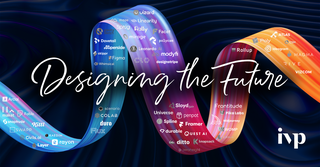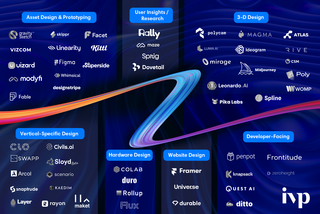Industry Insight
Designing the Future: How AI is Reshaping Product Design

At IVP, we’ve long believed that design is a critical component when it comes to building a long lasting company. This belief has led to our investments in companies like Figma, Slack, Discord, and Niantic – all of which have made intuitive, elegant design a centerpiece of their brands. Today, it feels like we’re on the precipice of a tectonic shift in the field of design; empowered by AI, a new generation of design tools and practices is set to emerge.
We wanted to take a closer look at how AI is actually impacting design, so we gathered an inspiring group of people – a mix of designers, researchers, founders, and executives – to get their perspectives on how AI is changing the way they work today and how it might impact their work in the future.
We were especially interested in exploring how AI might affect four key workflows in the design process:
- User Research
- Design Exploration
- Handoff from Design to Engineering
- The Role of Data
In putting together this research, we heard a wide range of predictions on how AI might change the future of product design. Some people told us they believed that AI would have little impact. Others said that AI will eradicate the role of product managers as we know it today.
We believe the truth is somewhere in the middle: AI will complete many of the rote, time-consuming tasks that take up a large part of a designer’s job, but it won’t replace the role of human intelligence or the jobs held by designers, engineers, or PMs. Instead, each of these roles will evolve to become increasingly multidisciplinary: designers will produce workable code, engineers will gather insights from users, and PMs will produce high-fidelity prototypes – all with the assistance of AI-powered tools.
Below, you’ll find a summary of our key learnings, a few bold predictions, and a non-exhaustive list of exciting companies we heard about during these interviews. If you’re building in this space, or if there are any companies we missed that you think we should know about, we’d love to hear from you!
User Research
User research is, by definition, bespoke. Unlike other workflows where the output is relatively consistent (e.g. a Figma prototype that is handed off to engineering to begin development), research output can refer to unified product feedback, a detailed evaluation of the core user base, or even a recommendation to change product strategies.
For this reason, we heard consistent excitement about how AI can automate the more laborious parts of the user research process, including setting up studies, recruiting users, personalizing surveys, and aggregating insights. It’s early innings here, but companies like Maze and Dovetail are already helping to drive this change.
User research is only as good as the quality of its sample size. Collecting feedback from what is truly a representative sample of a company’s customer base is incredibly difficult to do. AI provides for greater personalization at scale: Instead of asking survey participants to complete the same survey, what if every survey was customized to each user based on their prior responser history, product usage patterns, and current pricing plan?
In the future, user research teams will have access to more diverse forms of high-quality data as AI becomes more mainstream. For instance, the multimodal impact of AI across text, audio, and video may change the way we gather user research significantly in the coming years... For example, many users may not want to fill out a 5 or 10 minute post-purchase product feedback survey, but what if they could leave a 30-second audio review of the product? Already, AI tools can synthesize this type of feedback automatically and incorporate nuances in characteristics like tone and expression.
Bold Prediction: As it becomes easier to recruit participants and generate baseline feedback, it’s going to become harder to filter out the noise and determine what insights are most critical to a product’s success. As a result, quality research is going to become even more critical as a function. In turn, this will lead to more companies investing in research more broadly and we’ll likely see companies shifting hiring allocations from PMs to Research.
Design Exploration
Once the core user problem has been established, it’s time to explore how to solve it. A few themes emerged from our conversations about this phase:
- Breadth is critical. Narrowing in on a solution too quickly can lead to a local maximum that works well in the short term but causes more problems longer-term.
- In some companies, the designer works alone to develop and produce ideas. Others default to a more collaborative approach and use techniques like design sprints.
- Non-designers often engage in exploration and ideation. These people typically lack the specialized skills necessary to generate high-quality designs, but are key players with critical insights.
- Designers spend a significant amount of time attempting to accurately represent an idea or feature that a customer or PM has dreamed up.
For those who haven’t shipped products before, it can be shocking to learn how much time designers spend dealing with stakeholders. Unsurprisingly, we heard a great deal of optimism around democratizing access to higher-fidelity designs through AI. Additionally, we were pleasantly surprised to find that no one expressed concern over the fact that this might lead to an eventual commoditization of design.
Instead, teams across companies will work with even greater collaboration. Democratization will not only enable PMs and stakeholders to be active contributors, but will remove significant bottlenecks in the current design process. As one practitioner put it, if 3-person teams soon have the same leverage as the 15-person teams of today, the teams of tomorrow will require tight-knit, multi-disciplinary thinkers rather than siloed specialists.
Bold Prediction: Designers will increasingly delegate this process to PMs and spend their time on higher-order problems that require dedicated creativity and originality.
Handoff from Design to Engineering
To date, handoffs between Design and Engineering have been like the relay races we ran as kids in PE; there are lots of fumbles, lost momentum, and – perhaps more often than we’d like to admit – a faceplant. A lot of time is wasted on incorrect assumptions about the feasibility of a design or inconsistencies with existing components.
Moving forward, we anticipate these handoffs will become closer to what we see in the Olympics: perfectly executed with seamless transitions. The most impactful improvements likely include:
- Translating static designs into working prototypes to help convey the different paths a user might take
- Automatically updating designs with approved components (this is where products like Chromatic, Knapsack, and ZeroHeight come in)
- Generating production-ready FE code from a Figma design
The practitioners we spoke to believe, overwhelmingly, that PMs will become less critical to this workflow moving forward. A smoother handoff means there will be fewer disagreements about the scope and scale of a given feature, which, in turn, allows for more time spent iterating directly between Design and Engineering.
Bold Prediction: Designers will be able to take a Figma design, translate it into functional-enough code, specify where it will live in the app, and then automatically build and spin up a CDE to validate the updated design.
The Role of Data
Historically, only big consumer companies have had the resources to invest in the tooling required to build a unified picture of their users’ behavior. While more early-stage companies have invested in product analytics during the past decade, for the majority of new companies, generating quality insights is still too time-consuming to be practical.
We heard a lot of excitement about the ability to more easily generate insights through AI-based tooling. Companies will soon have the ability to synthesize user journeys, funnels, survey data, and in-app feedback. One founder compared generating quality customer insights today manually navigating Windows Explorer. Soon, it’s going to look and feel like the streamlined approach of Google Drive, with instant access to the data and insights you need.
While it’s unclear if these workflows will be driven by enterprise search, a universal semantic layer, or next-gen tooling for product engineers, it’s obvious that access to quality product feedback will become a necessity for companies moving forward.
Bold Prediction: Bundling is nigh. Companies are tired of using different products across event capture, product analytics, experimentation, and surveys. Instead, they’re looking for all-in-one, warehouse-native solutions that integrate with Figma and neatly fit into a designer’s workflow.
Companies Building the Future of Design
Innovation in design, fueled by recent developments in AI, is well underway. The next few years will usher in an era of sweeping transformation. From our conversations with founders and designers, it’s clear that AI is rapidly lowering the barrier to entry in order to successfully execute concepts and ideas.
Below, we share a list of companies that came up repeatedly during our conversations. These are products that founders and designers are either excited about or currently use to complete their daily work. While this list is by no means exhaustive, all of these companies are using AI in some form to augment the design process.

Special thank you to Tony Beltramelli (Uizard), Anooja Chitnis (JPM), Badrul Farooqi (ex-Figma, now Cursor Capital), James Hawkins (Posthog), Scott Luttman (Grain), Ryan Ma (Contrary), Nizar Saqqar (Snowflake), Chloe Thai (Carta), and many others who helped us make sense of this rapidly changing landscape.
We are excited to spend more time exploring and investing in the Future of Design - if you are building here, please reach out to us at snarayen@ivp.com, kramakrishnan@ivp.com, ckuo@ivp.com, and sgarg@ivp.com.
Asset Design & Prototyping
- Gravity Sketch
- Vizcom
- Uizard
- Modyfi
- Fable
- Linearity
- Kittl
- Facet
- Superside
- Whimsical
- Designstripe
- Figma
Website Design
3D Design
- Midjourney
- Spline
- Leonardo
- Mirage
- Luma AI
- Polycam
- Magma
- Poly
- Atlas
- Rive
- Ideogram
- Pika Labs
- Common Sense Machines
- Womp
User Insights / Research
Vertical-Specific Design
Hardware Design
Developer-Facing


